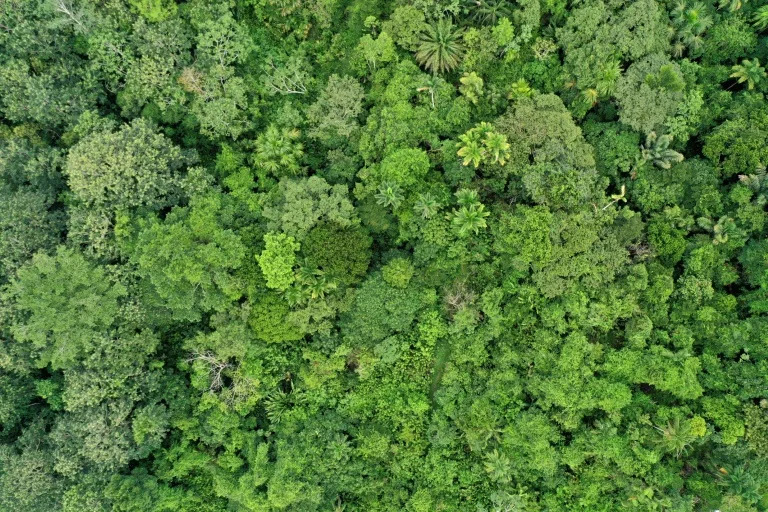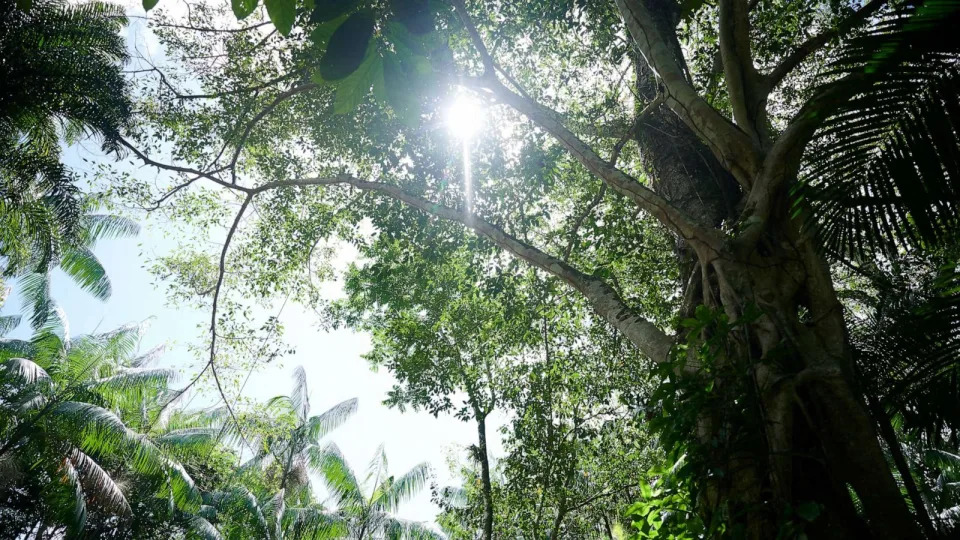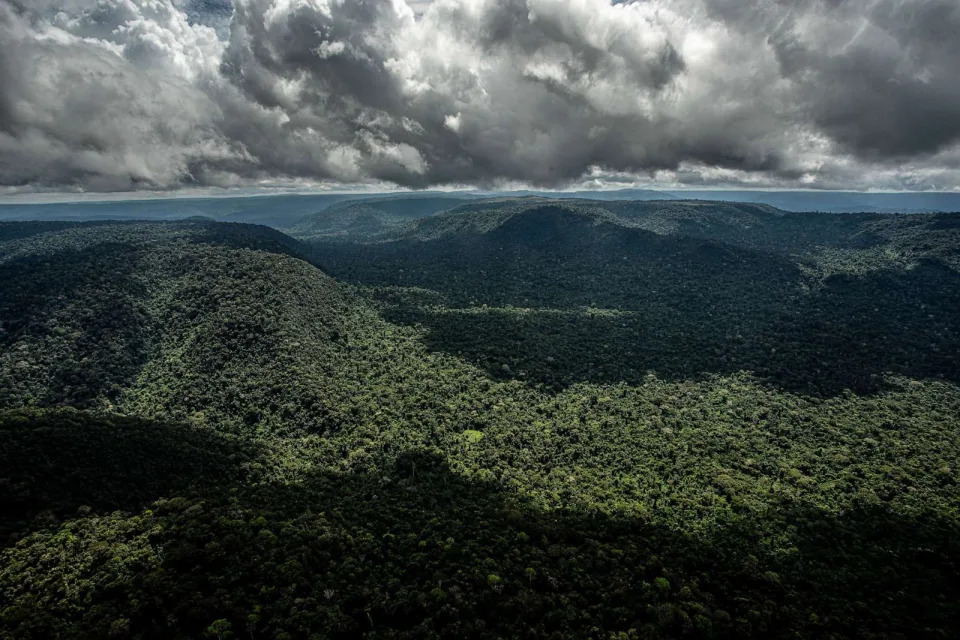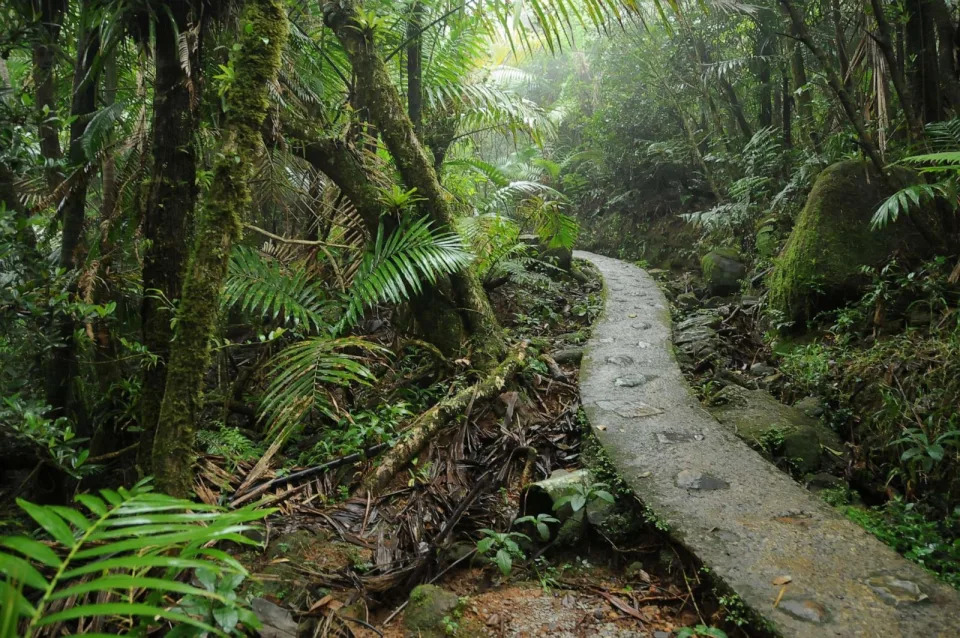Linnea Pedersen
Wed, August 23, 2023

The new research suggests that leaf death could become a new factor in the predicted "tipping point" where tropical forests transition due to climate change and deforestation into savannah-like landscapes.
Global warming is driving leafy tropical canopies close to temperatures where they can no longer transform sunlight and CO2 into energy, threatening total collapse if the thermometer keeps climbing, according to a study Thursday.
A tiny percentage of upper canopy leaves have already crossed that threshold, reaching temperatures so high -- above 47 degrees Celsius -- as to prevent photosynthesis, the study published in Nature reported.
Currently, some leaves exceed such critical temperatures only 0.01 percent of the time, but impacts could quickly scale up because leaves warm faster than air, the researchers said.
"You heat the air by two to three degrees and the actual upper temperature of these leaves goes up by eight degrees," lead author Christopher Doughty of Northern Arizona University told journalists.
If tropical forest's average surface temperature warms 4C above current levels -- widely considered a worst-case scenario -- "we're predicting possible total leaf death," he said.
The new research suggests that leaf death could become a new factor in the predicted "tipping point" whereby tropical forests transition due to climate change and deforestation into savannah-like landscapes.
If air temperatures increase unabated by 0.03 C per year, the study projected, mass mortality among the canopies could happen in a little more than a century.
Doughty and his team used data from the NASA ECOSTRESS satellite -- designed to measure plant temperatures -- validated with ground observations, based in part on sensors attached to individual leaves.
- Increased tree death -
There remain uncertainties as to how high leaf temperatures might impact the forest as a whole, the scientists cautioned.
"Believe it or not, we don't know terribly much about why trees die," said co-author Gregory Goldsmith of Chapman University.
It doesn't take a scientist to know that when a tree loses its roots it dies, he said.
But the interactions and feedbacks between heat and drought -- and water and temperature -- on overall tree health aren't as clear.
Total leaf death might not necessarily mean total tree death.
The critical temperature at which leaves turn brown and die might also differ by species, depending on the size and thickness of their leaves and the breadth of their canopy.
But there are already concerning signs. In the Amazon, where temperatures are higher than in other tropical forests, the rate at which trees are dying has increased in recent decades.
"The Amazon is currently experiencing higher levels of mortality than Central Africa and that could possibly be due to the high temperatures we've seen there," said Doughty.
Increased fragmentation of the forests from deforestation has also been shown to make the remaining forest areas warmer.
Tropical biomes contain 45 percent of the Earth's forests, and play an outsized role in absorbing human-caused carbon pollution.
They also harbour half or more of the world's plant biodiversity, with at least 40,000 different tree species, according to the Intergovernmental Panel on Climate Change (IPCC).
The fact that a few leaves are overheating at current temperatures is a "canary in the coal mine," said senior author Joshua Fisher of Chapman University.
"You want to be able to detect something happening before it's widespread," he said.
"The fact that we can do that now gives us that ability to actually do something as a collective society."
Scientists not involved in the study said it should serve as a warning that nature's capacity to adapt to climate change has limits.
"It is true that trees and other kinds of vegetation can soak up emissions and provide cooling," commented Leslie Mabon, a lecturer in environmental systems at The Open University.
"However, this study illustrates that without concerted action by humans to reduce emissions and limit global heating at the same time as protecting and enhancing nature, some functions of nature may start to break down at higher temperatures."
JULIA JACOBO
Wed, August 23, 2023
Scientists have recently discovered a phenomenon occurring in tropical forests that could be of great concern if global warming continues unabated.
Climate change has caused the leaves on some plants in tropical forests to stop undergoing photosynthesis -- the process in which plants and other organisms use sunlight to synthesize foods from carbon dioxide and water, according to a study published Wednesday in Nature.
"When leaves reach a certain temperature, their photosynthetic machinery breaks down," Gregory Goldsmith, a professor of biology at Chapman University in Orange, California, told reporters.

PHOTO: The sun shines through the rainforest near Belem, Brazil, June 7, 2023. (Picture Alliance via Getty Images)
This study is really the first to establish the limits of these tropical forest canopies, Goldsmith said.
MORE: How climate change could hinder reforestation efforts, according to experts
The analysis indicates that tropical forests may be approaching the maximum temperature threshold for photosynthesis to work, the researchers found.
Researchers used high-resolution measurements taken from an instrument on board the International Space Station between 2018 and 2020. They also placed sensors on top of tree canopies in places like Brazil, Puerto Rico and Australia to estimate peak tropical-forest canopy temperatures.

PHOTO: The National Forest in the Carajas mountain range, Para state, Brazil, May 17, 2023. (Dado Galdieri/Bloomberg via Getty Images)
They found many of the leaves are approaching a critical temperature threshold, according to Christopher Doughty, a professor in infomatics, computing and cyber systems and lead author of the study.
The data shows that canopy temperatures peaked at around 34 degrees Celsius -- or 93.2 degrees Fahrenheit -- on average, although a small proportion of those observed exceeded 40 degrees Celsius, or 104 degrees Fahrenheit.
MORE: Forests in Brazil emitting more carbon than they absorb due to climate change: Study
Researchers are "just starting to see" these temperatures light up throughout forests, Joshua Fisher, a climate scientist with a focus on terrestrial ecosystems at Chapman University, told reporters at Monday's news conference.
The percentage of leaves that began to fail was small -- just an estimated .01% of all leaves in the forests studied, according to the study. But warming experiments predict this value will rise to 1.4% under future warming conditions.

PHOTO: Falls on Mother Cummings Rivulet in Meander Forest Reserve, Great Western Tiers, Tasmania, Australia. (Auscape/Universal Images Group via Getty)
The critical temperature beyond which photosynthetic machinery in tropical trees begins to fail averages at about 46.7 degrees Celsius or about 116 degrees Fahrenheit.
MORE: Why reforestation is a crucial part of saving the environment
Modeling suggests that tropical forests can withstand up to a 3.9 degree Celsius increase over current air temperatures before a potential tipping point is reached, which is within the worst-case scenario for climate predictions and possible, the researchers found.
"There's a potential for a tipping point in these forest," Doughty said.

PHOTO: A trail in the rain forest of El Yunque National Forest, Puerto Rico, Jan. 1, 2011. (Diego Cupolo/NurPhoto via Getty Images)
Known as the the carbon sinks of the world, tropical forests serve as critical carbon storage due to their capture and pack away carbon dioxide from the atmosphere. In addition, they hold most of the world species, which is why it is important to understand future temperatures and tropical forests, Doughty said.
"There's all sorts of potential feedbacks once you start losing bits of forest," he said.
Ambitious climate change mitigation goals and reduced deforestation are needed to help forests stay below thermally critical thresholds, the authors found.
Laura Paddison, CNN
Wed, August 23, 2023
Some leaves in tropical forests from South America to South East Asia are getting so hot they may no longer be able to photosynthesize, with big potential consequences for the world’s forests, according to a new study.
Leaves’ ability to photosynthesize – the process by which they make energy from carbon dioxide, sunlight and water – begins to fail when their temperature reaches around 46.7 degrees Celsius (116 Fahrenheit).
While this may seem high, leaves can get much hotter than the air temperature, according to the report published Wednesday in Nature by a group of scientists from countries including the US, Australia and Brazil.
The scientists used temperature data beamed down from thermal satellite sensors on the International Space Station, 400 kilometers (nearly 250 miles) above the Earth. They combined this with on-the-ground observations from leaf-warming experiments, in which scientists climbed into the canopy to painstakingly add sensors to leaves.
Rather than looking at average temperatures, the scientists were looking at extremes, said Christopher Doughty, associate professor in ecoinformatics at Northern Arizona University and a report author. They found that average forest canopy temperatures peaked at 34 degrees Celsius (93 Fahrenheit) but some exceeded 40 degrees Celsius (104 Fahrenheit).
Currently, 0.01% of leaves are passing the critical temperature threshold beyond which their ability to photosynthesize breaks down, the report found, potentially killing the leaf and the tree.
This percentage, while small, is poised to increase as the world warms, the report said, posing a threat to the world’s tropical forests – which cover roughly 12% of the planet and hold more than half of the world’s species. They also provide a vital role in sucking up and storing carbon and helping to regulate the global climate.
“There are all sorts of potential feedbacks once you start losing bits of forests, even leaves on individual trees,” Doughty said on a call with reporters.
Tropical rainforest in the Mobuku Valley, Uganda. - Martin Zwick/REDA&CO/Universal Images Group/Getty Images
Tropical forests can withstand around 4 degrees Celsius (7.2 Fahrenheit) of additional global warming before they reach a tipping point in terms of their ability to photosynthesize, according to the report.
If warming exceeds this level, the amount of leaves surpassing critical temperature thresholds could rise to 1.4%, potentially causing large-scale leaf loss and the death of the whole tree, the report found.
This level of warming is not expected under current climate policies, which are estimated to bring 2.7 degrees Celsius of warming above pre-industrial levels. But it is within the range of the most pessimistic climate scenarios if the world continues to burn fossil fuels.
While these figures may seem small, the risk is significant given how critical tropical trees are for life, the climate system and the planet.
“Almost all life – including humans – is dependent on photosynthesis for food either directly or indirectly,” said Kevin Collins, senior lecturer in environment and systems at the Open University, who was not involved in the research.
The findings indicate that global warming is putting this vital process at risk, he told the Science Media Centre. But, he added, there are more immediate concerns for tropical forests, including deforestation, wildfires and droughts.
Christopher Still, a forest ecosystem professor at Oregon State University, also not involved in the report, said that the research provided some novel insights. While there’s been a big focus on the impact of drought on tree loss, he told CNN, “this paper says it’s not just drought – we need to really also worry about the temperatures that leaves are reaching.”
While he acknowledged the numbers in the report are small, he added, “I would focus a little bit less on the percentages, and more on the concepts of leaves pushing up against these really high temperature conditions and how often that happens, how long it lasts and what it really means.”
Others were more cautious. Chloe Brimicombe, a climate scientist at the University of Graz in Austria, said that given how few leaves are reaching the critical temperature threshold, and how high warming would need to get before a tipping point, “this suggests in theory tropical forests are quite resilient to climate change.”
She told the Science Media Centre, “this is a simple model and trees and forest dynamics are much more complex than this.”
The report authors said despite uncertainties, the research gives important insights around how tropical forests will respond to climate change.
“It’s a little bit of a canary in the coal mine that we’re starting to see,” Joshua Fisher, a climate scientist at Chapman University and a report author, said on a call with reporters. “And you want to be able to detect something happening before it’s widespread.”

No comments:
Post a Comment